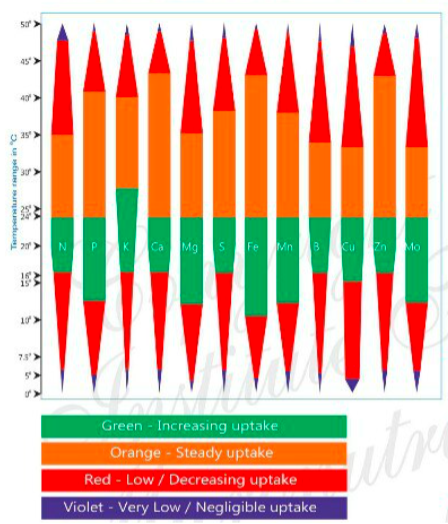ILSOYADVISOR POST
Do Nutrients Have Parkas?
Many have heard that pH affects nutrient availability in their soil or uptake by the plant. We try to have pH around 6.0 to 6.5 so as many nutrients as possible are in their maximum level of availability (see Figure 1). We’ve learned that managing pH can increase uptake and set the plant up for maximum yield potential. It’s possible to manage pH, but we can’t manage temperatures, so what do various temperatures do to this nutrient availability or uptake?

Figure 1. Nutrient availability by pH. This graph shows how the different nutrients are available across various pH levels.
As temperatures drop, nutrient uptake does too. Think about it this way, when you walk outside on a cold blustery day with no jacket, do you want to do much out there? Not usually. In most cases, work goes a little slower, things take a little longer and we may not work nearly as efficiently as we normally do. So is the case with plants and nutrient uptake. Figure 2 shows the temperature ranges of nutrient uptake. When the temperature is below 10 degrees C, slow cell function and low nutrient uptake can be expected which results in slow vegetative growth and possibly signs of various nutrient deficiencies (if the plants are far enough along). Between 10 degrees C and 24 degrees C, nutrient uptake is fairly normal with an increase of uptake of all nutrients above 16 degrees C. Sixteen to 24 degrees C is the optimum range for all nutrients and given all other conditions are favorable, plants will show optimum growth.

Figure 2. Nutrient availability by temperature. This figure shows which nutrients are available at various temperatures. Note: temperatures are in degrees C. Sixteen degrees C is approximately 60.8 degrees F, 15 degrees C is approximately 59 degrees F and 10 degrees C is approximately 50 degrees F.
How does this information help? What can be done about it? Planting time is filled with decisions, knowing the forecast can help gauge expectations and help make management decisions around adding fertility of key nutrients to make sure these nutrients are readily available, and uptake is as efficient as possible when the soils are cool.
References: Institute for Micronutrient Technology, Effect of temperature on the uptake of nutrients





Comments
Add new comment